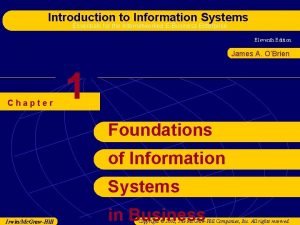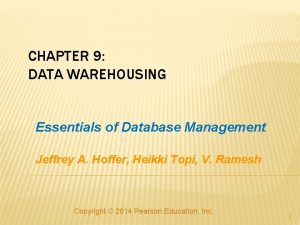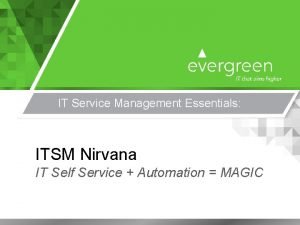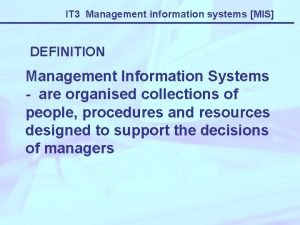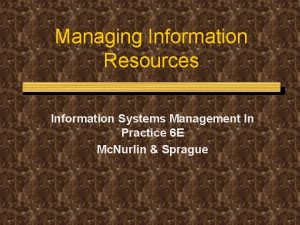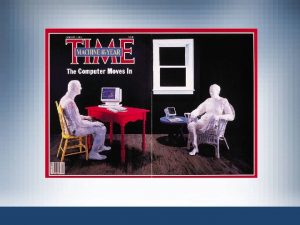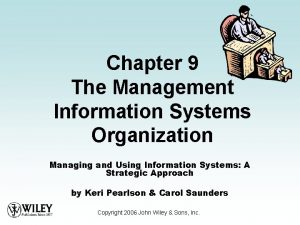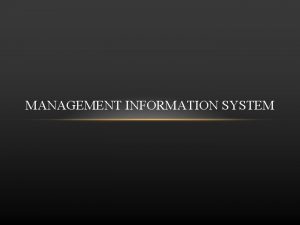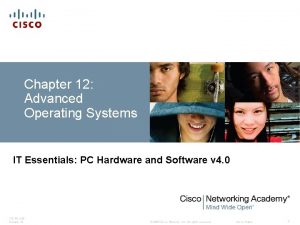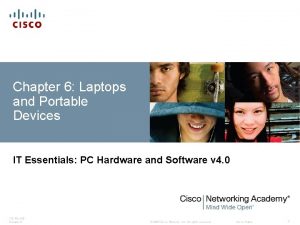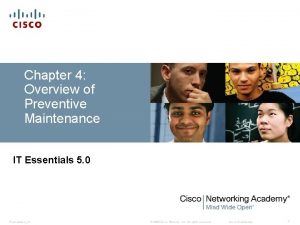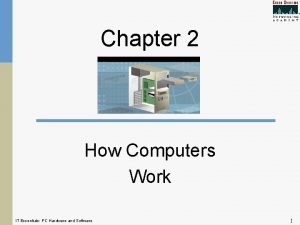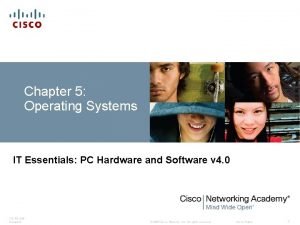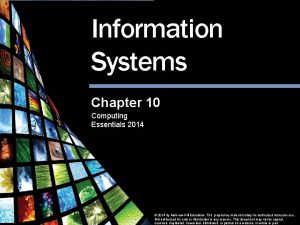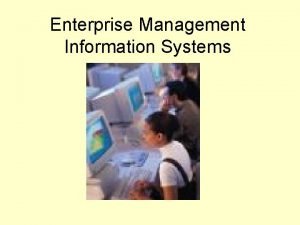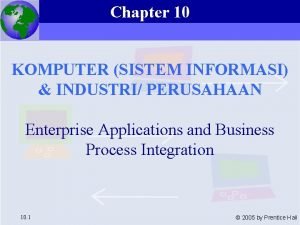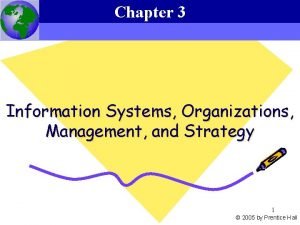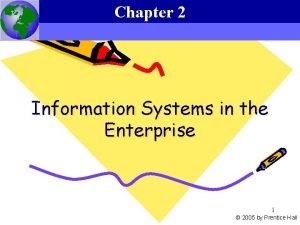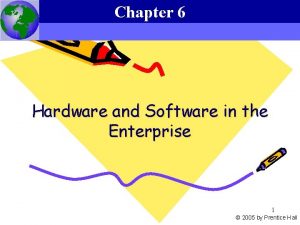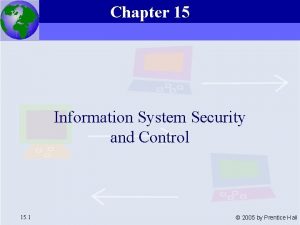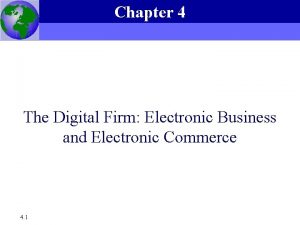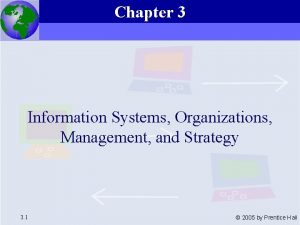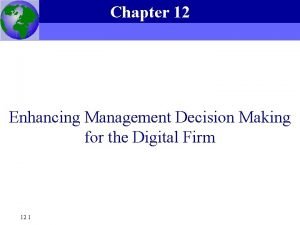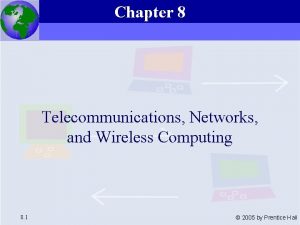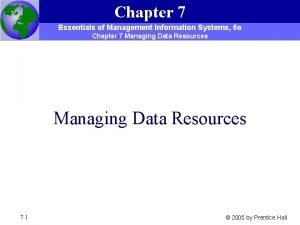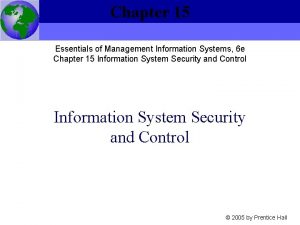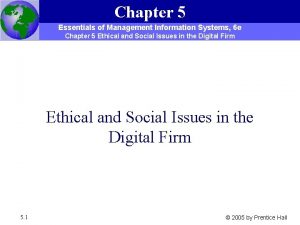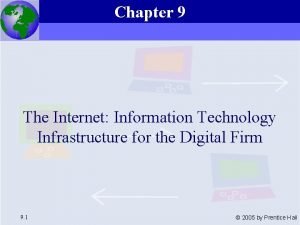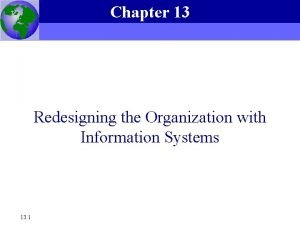Chapter 14 Essentials of Management Information Systems 6















































- Slides: 47

Chapter 14 Essentials of Management Information Systems, 6 e Chapter 14 Understanding the Business Value of Systems and Managing Change 14. 1

Essentials of Management Information Systems, 6 e Chapter 14 Understanding the Business Value of Systems and Managing Change Objectives 1. How can our company measure the business benefits of our information systems? What models should be used to measure that business value? 2. Why do so many system projects fail? What are the principal reasons for system failures? 3. How should the organizational change surrounding a new system be managed to ensure success? 14. 2

Essentials of Management Information Systems, 6 e Chapter 14 Understanding the Business Value of Systems and Managing Change Objectives 4. Are there any special challenges to implementing international information systems? 5. What strategies can an organization use to manage the system implementation process more effectively? 14. 3

Essentials of Management Information Systems, 6 e Chapter 14 Understanding the Business Value of Systems and Managing Change Management Challenges 1. Determining benefits and costs of a system when they are difficult to quantify. 2. Dealing with the complexity of large-scale systems projects. 14. 4

Essentials of Management Information Systems, 6 e Chapter 14 Understanding the Business Value of Systems and Managing Change Understanding the Business Value of Information Systems Two Kinds of Information System Investments • • 14. 5 System Projects Infrastructure

Essentials of Management Information Systems, 6 e Chapter 14 Understanding the Business Value of Systems and Managing Change Understanding the Business Value of Information Systems IT Investment Values • • Improvement in business processes Improvement in management decision making Longer Term Values • • 14. 6 Improve strategic position Implement new technologies and products

Essentials of Management Information Systems, 6 e Chapter 14 Understanding the Business Value of Systems and Managing Change Understanding the Business Value of Information Systems Traditional Capital Budgeting Models • • Capital Budgeting Rely on measuring cash inflows and outflows 6 capital budgeting models • • • 14. 7 Payback method Accounting rate of return on investment (ROI) Net present value Cost-benefit ratio Profitability index Internal rate of return (IRR)

Essentials of Management Information Systems, 6 e Chapter 14 Understanding the Business Value of Systems and Managing Change Understanding the Business Value of Information Systems Traditional Capital Budgeting Models Costs and Benefits of Information Systems • • Costs: • Hardware, telecommunications, software, services, personnel Tangible benefits (cost savings): • • Intangible benefits: • 14. 8 Increased productivity, lower operational costs, reduced workforce, etc. Improved asset utilization, improved resource control, improved organizational planning, etc.

Essentials of Management Information Systems, 6 e Chapter 14 Understanding the Business Value of Systems and Managing Change Understanding the Business Value of Information Systems Traditional Capital Budgeting Models Limitations of Financial Models • • 14. 9 Costs and benefits don’t occur in same time frame Difficulties in measuring intangible benefits Bias toward applications with specific business functions Overlook social and organizational costs and benefits

Essentials of Management Information Systems, 6 e Chapter 14 Understanding the Business Value of Systems and Managing Change Understanding the Business Value of Information Systems Case Example: Capital Budgeting for a New Supply Chain Management System Heartland Stores General merchandise retail chain upgrading supply chain management system • Reduce inventory costs: Items stocked in inventory • Reduce labor costs: Inventory and tracking personnel • Reduce telecommunication costs: Less time on phone tracking inventory and shipments • Reduce transportation costs: Consolidating shipments, more efficient shipping schedules 14. 10

Essentials of Management Information Systems, 6 e Chapter 14 Understanding the Business Value of Systems and Managing Change Understanding the Business Value of Information Systems Costs and benefits of the new supply chain management system Figure 14 -1 14. 11

Essentials of Management Information Systems, 6 e Chapter 14 Understanding the Business Value of Systems and Managing Change Understanding the Business Value of Information Systems Financial models Figure 14 -2 14. 12

Essentials of Management Information Systems, 6 e Chapter 14 Understanding the Business Value of Systems and Managing Change Understanding the Business Value of Information Systems Case Example: Capital Budgeting for a New Supply Chain Management System Payback Method Time required to pay back initial investment of project Original investment Number of years to pay back = Annual net cash inflow 14. 13

Essentials of Management Information Systems, 6 e Chapter 14 Understanding the Business Value of Systems and Managing Change Understanding the Business Value of Information Systems Case Example: Capital Budgeting for a New Supply Chain Management System Accounting Rate of Return on Investment (ROI) Desired rate of return must equal or exceed cost of capital (Total benefits – Total cost – Depreciation) Useful life Net benefit Total initial investment 14. 14 = Net benefit = ROI

Essentials of Management Information Systems, 6 e Chapter 14 Understanding the Business Value of Systems and Managing Change Understanding the Business Value of Information Systems Case Example: Capital Budgeting for a New Supply Chain Management System Net Present Value Compare investment with future savings and earnings Present value of expected cash flows 14. 15 - Initial investment = cost Net present value

Essentials of Management Information Systems, 6 e Chapter 14 Understanding the Business Value of Systems and Managing Change Understanding the Business Value of Information Systems Case Example: Capital Budgeting for a New Supply Chain Management System Cost-Benefit Ratio of benefits to cost Total benefits Total costs 14. 16 = Cost-benefit ratio

Essentials of Management Information Systems, 6 e Chapter 14 Understanding the Business Value of Systems and Managing Change Understanding the Business Value of Information Systems Case Example: Capital Budgeting for a New Supply Chain Management System Profitability Index Allows ranking of different possible investments Present value of cash inflows Investment 14. 17 = Profitability index

Essentials of Management Information Systems, 6 e Chapter 14 Understanding the Business Value of Systems and Managing Change Understanding the Business Value of Information Systems Case Example: Capital Budgeting for a New Supply Chain Management System Internal Rate of Return (IRR) • Rate of return, or profit, that an investment is expected to earn • Discount (interest) rate that will equate the present value of the projects future cash flows to the initial investment cost 14. 18

Essentials of Management Information Systems, 6 e Chapter 14 Understanding the Business Value of Systems and Managing Change Understanding the Business Value of Information Systems Strategic Considerations Portfolio Analysis of portfolio of potential applications to determine risks and benefits, and select among alternatives Scoring Models Method for deciding among alternative systems based on a system of ratings 14. 19

Essentials of Management Information Systems, 6 e Chapter 14 Understanding the Business Value of Systems and Managing Change Understanding the Business Value of Information Systems A system portfolio Figure 14 -3 14. 20

Essentials of Management Information Systems, 6 e Chapter 14 Understanding the Business Value of Systems and Managing Change Understanding the Business Value of Information Systems Strategic Considerations Real Options Pricing Models using techniques for valuing financial options to evaluate information technology investments with uncertain returns Knowledge Value–Added Approach • • 14. 21 Focuses on knowledge input into a business process Determines costs and benefits of changes in business processes from new information systems

Essentials of Management Information Systems, 6 e Chapter 14 Understanding the Business Value of Systems and Managing Change Understanding the Business Value of Information Systems Information Technology Investments and Productivity Multi-Factor Productivity • Measure of firm’s efficiency in converting inputs to outputs • Amount of capital and labor required to produce a unit of output • “Productivity Paradox” 14. 22

Essentials of Management Information Systems, 6 e Chapter 14 Understanding the Business Value of Systems and Managing Change Understanding the Business Value of Information Systems Information Technology Investments and Productivity Information Technology Contributions • Manufacturing: Increased productivity • Service sector: Benefits unclear • Information and knowledge industries: Benefits difficult to measure 14. 23

Essentials of Management Information Systems, 6 e Chapter 14 Understanding the Business Value of Systems and Managing Change The Importance of Change Management in Information System Success and Failure Information system problem areas Figure 14 -4 14. 24

Essentials of Management Information Systems, 6 e Chapter 14 Understanding the Business Value of Systems and Managing Change The Importance of Change Management in Information System Success and Failure Information System Problem Areas • Design • • • 14. 25 Failure to capture essential business requirements Information in difficult to use format; poor user interface Incompatible with organization structure, culture, goals

Essentials of Management Information Systems, 6 e Chapter 14 Understanding the Business Value of Systems and Managing Change The Importance of Change Management in Information System Success and Failure Information System Problem Areas • Data • • • Cost to implement and run prohibitive Operations • • 14. 26 Inaccuracy, inconsistency of data Not organized properly for business purposes Computer operations breaking down Information delays, slow response times

Essentials of Management Information Systems, 6 e Chapter 14 Understanding the Business Value of Systems and Managing Change The Importance of Change Management in Information System Success and Failure Change Management and the Concept of Implementation • Implementation • • Change Agent • 14. 27 All organizational activities working toward the adoption, management, and routinization of an innovation Individual acting as catalyst during the change process

Essentials of Management Information Systems, 6 e Chapter 14 Understanding the Business Value of Systems and Managing Change The Importance of Change Management in Information System Success and Failure Causes of Implementation Success and Failure • User Involvement and Influence • • 14. 28 Molding system to user priorities and business requirements Positive involvement in system Users can take limited view of system User-designer communications gap

Essentials of Management Information Systems, 6 e Chapter 14 Understanding the Business Value of Systems and Managing Change The Importance of Change Management in Information System Success and Failure Factors in information system success or failure Figure 14 -5 14. 29

Essentials of Management Information Systems, 6 e Chapter 14 Understanding the Business Value of Systems and Managing Change The Importance of Change Management in Information System Success and Failure Causes of Implementation Success and Failure • Management Support and Commitment • • 14. 30 Positive perception Inducement to participation Sufficient funding and resources Enforcement of workflow changes

Essentials of Management Information Systems, 6 e Chapter 14 Understanding the Business Value of Systems and Managing Change The Importance of Change Management in Information System Success and Failure Causes of Implementation Success and Failure • Level of Complexity and Risk • • • 14. 31 Project size: Greater risk with larger projects Project structure: Greater risk with less defined outputs and processes Experience with technology: Greater risk if project team and information systems staff lack required expertise

Essentials of Management Information Systems, 6 e Chapter 14 Understanding the Business Value of Systems and Managing Change The Importance of Change Management in Information System Success and Failure Causes of Implementation Success and Failure Results of Poorly Managed Systems Projects • • 14. 32 Costs that vastly exceed budgets Unexpected time slippage Technical shortfall; poor performance Failure to obtain anticipated benefits

Essentials of Management Information Systems, 6 e Chapter 14 Understanding the Business Value of Systems and Managing Change The Importance of Change Management in Information System Success and Failure Consequences of poor project management Figure 14 -6 14. 33

Essentials of Management Information Systems, 6 e Chapter 14 Understanding the Business Value of Systems and Managing Change The Importance of Change Management in Information System Success and Failure Causes of Implementation Success and Failure Factors in Poor Management: • • Ignorance and optimism The mythical man-month • • Falling behind • 14. 34 When adding labor can slow productivity Bad news travels slowly upward

Essentials of Management Information Systems, 6 e Chapter 14 Understanding the Business Value of Systems and Managing Change The Importance of Change Management in Information System Success and Failure Change Management Challenges for Business Process Reengineering (BPR) Enterprise Applications, and Mergers and Acquisitions • • 14. 35 70% failure rate in BPR projects High failure rate in enterprise applications Poor implementation; inadequate change management M&As: Require considerable organizational change and system projects to combine information systems of two companies

Essentials of Management Information Systems, 6 e Chapter 14 Understanding the Business Value of Systems and Managing Change The Importance of Change Management in Information System Success and Failure The Challenge of Implementing Global Systems • Disparate information requirements and business processes • • 14. 36 Local facility differences National accounting laws Transborder data flow Language

Essentials of Management Information Systems, 6 e Chapter 14 Understanding the Business Value of Systems and Managing Change The Importance of Change Management in Information System Success and Failure The Challenge of Implementing Global Systems • Technology hurdles: lack of standards and connectivity • • • 14. 37 Standardizing computer hardware platform Software for international teamwork Integrated global networks difficult, costly to install Standards for networking and EDI are industry and country specific Local user resistance to global systems

Essentials of Management Information Systems, 6 e Chapter 14 Understanding the Business Value of Systems and Managing Change The Importance of Change Management in Information System Success and Failure Window on Organizations Global E-Commerce: Good and Bad News What management, organization, and technology issues should be addressed when developing a global Web strategy? 14. 38

Essentials of Management Information Systems, 6 e Chapter 14 Understanding the Business Value of Systems and Managing Change Managing Implementation Controlling Risk Factors • Managing technical complexity • • Formal planning and control tools • • • Program Evaluation and Review Technique (PERT) Gantt charts Increasing user involvement and overcoming user resistance • • 14. 39 Internal integration tools External integration tools User participation, education and training, incentives

Essentials of Management Information Systems, 6 e Chapter 14 Understanding the Business Value of Systems and Managing Change Managing Implementation Formal planning and control tools help to manage information systems projects successfully Figure 14 -7 14. 40

Essentials of Management Information Systems, 6 e Chapter 14 Understanding the Business Value of Systems and Managing Change Managing Implementation Designing for the Organizational Factors in Systems Planning and Implementation • • 14. 41 Employee participation and involvement Job design Standards and performance monitoring Ergonomics Employee grievance resolution procedures Health and safety Government regulatory compliance

Essentials of Management Information Systems, 6 e Chapter 14 Understanding the Business Value of Systems and Managing Change Managing Implementation Designing for the Organization • • 14. 42 Organizational impact analysis • Study of how a proposed system will affect the organization structure, attitudes, decision making, and operations Sociotechnical design • Establishes human objectives • Separate sets of technical and social design solutions • Design based on best fit to technical and social needs

Essentials of Management Information Systems, 6 e Chapter 14 Understanding the Business Value of Systems and Managing Change Managing Implementation Managing Global Implementations • • Limit transnational development to core systems Cooptation • • • Separate transnational systems developed by separate country units Global technology infrastructure • • 14. 43 Bringing opposition into development process International private network, VANs Internet technology: VPNs, intranets

Essentials of Management Information Systems, 6 e Chapter 14 Understanding the Business Value of Systems and Managing Change Managing Implementation Local, regional, and global systems Figure 14 -8 14. 44

Essentials of Management Information Systems, 6 e Chapter 14 Understanding the Business Value of Systems and Managing Change Managing Implementation “Fourth Generation” Project Management • Project planning as an enterprise-wide focus • Managers focus on solving problems as they arise and meeting challenges • Seek ways to adapt to unforeseen uncertainties that could provide additional opportunities 14. 45

Essentials of Management Information Systems, 6 e Chapter 14 Understanding the Business Value of Systems and Managing Change Chapter 14 Case Study Cigna Stumbles with a New Customer Service System 1. Evaluate Cigna using the value chain and competitive forces models. What was Cigna’s business strategy? 2. What was the relationship of its information systems to Cigna’s business systems and business strategy? How well did its systems support its strategy? How did they provide value for the company? 3. What management, organization, and technology factors contributed to Cigna’s problems? 14. 46

Essentials of Management Information Systems, 6 e Chapter 14 Understanding the Business Value of Systems and Managing Change Chapter 14 Case Study Cigna Stumbles with a New Customer Service System 4. Classify and describe the problems that Cigna faced in trying to modernize its customer-facing systems using the categories described in this chapter on the causes of system failure. 5. Evaluate the risks of the Cigna systems modernization project as seen at its outset, and then outline its key risk factors. Describe the steps you would have taken during the planning stage of the project to control these factors. 14. 47
 Essentials of mis, 13th edition
Essentials of mis, 13th edition Essentials of information systems
Essentials of information systems Functions of an information system
Functions of an information system Introduction of management information system
Introduction of management information system Essentials of systems analysis and design
Essentials of systems analysis and design Essentials of migration management
Essentials of migration management Data warehouse essentials
Data warehouse essentials Purdue project management
Purdue project management Essentials of migration management
Essentials of migration management Essentials of nursing leadership & management
Essentials of nursing leadership & management Essentials of migration management
Essentials of migration management Service management essentials
Service management essentials Level of management in an organization
Level of management in an organization What is management information systems
What is management information systems Information systems management in practice
Information systems management in practice Vertical
Vertical Specialized information systems
Specialized information systems Mis chapter 9
Mis chapter 9 Management information systems effy oz
Management information systems effy oz Introduction to management information systems 5th edition
Introduction to management information systems 5th edition Management information systems managing the digital firm
Management information systems managing the digital firm Introduction of mis
Introduction of mis It essential chapter 8
It essential chapter 8 5 essentials for a successful ffa chapter
5 essentials for a successful ffa chapter It essentials chapter 9
It essentials chapter 9 It essential chapter 14
It essential chapter 14 It essentials chapter 12
It essentials chapter 12 It essentials chapter 11
It essentials chapter 11 Business essentials 12th edition chapter 1
Business essentials 12th edition chapter 1 Marketing essentials chapter 38
Marketing essentials chapter 38 Chapter 13 initiating the sale
Chapter 13 initiating the sale Form utilities
Form utilities It essential chapter 5
It essential chapter 5 It essentials chapter 3
It essentials chapter 3 It essentials chapter 11
It essentials chapter 11 Essentials of social media marketing chapter 9 quiz
Essentials of social media marketing chapter 9 quiz It essentials chapter 7
It essentials chapter 7 It essentials chapter 6
It essentials chapter 6 It essentials chapter 5
It essentials chapter 5 It essentials chapter 4
It essentials chapter 4 Math is the foundation of the kitchen and the back office
Math is the foundation of the kitchen and the back office It essentials chapter 2
It essentials chapter 2 It essentials chapter 5
It essentials chapter 5 Cisco it essentials virtual desktop pc assembly online
Cisco it essentials virtual desktop pc assembly online It essentials chapter 10
It essentials chapter 10 It essentials chapter 10
It essentials chapter 10 Ad altare dei answer key
Ad altare dei answer key Marketing essentials chapter 2
Marketing essentials chapter 2

